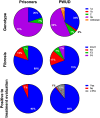Hepatitis C outreach project and cross-sectional epidemiology in high-risk populations in Trondheim, Norway
- PMID: 34733508
- PMCID: PMC8558792
- DOI: 10.1177/20499361211053929
Hepatitis C outreach project and cross-sectional epidemiology in high-risk populations in Trondheim, Norway
Abstract
Background: Hepatitis C is highly prevalent among people who use drugs (PWUD), and the hepatitis C virus (HCV) epidemic is less characterised in Norway. The aims of the study were to assess the prevalence and treatment willingness in high-risk populations by reaching out to frequently visited sites for high-risk populations.
Methods: Individuals from high-risk populations were included from September 2015 to March 2017. Two dedicated study nurses frequently visited the local opioid substitution clinic, outpatient clinics, PWUD day centres, local prison, and refugee centre in Trondheim, Norway. Demographic data, risk behaviour, and clinical symptoms were obtained by study questionnaire. Subjects with anti-HCV+ rapid test were subsequently tested for HCV RNA and genotyped. Viraemic patients were offered referral for HCV treatment evaluation.
Results: A total of 381 participants were included in the study: 52 immigrants, 62 prisoners, and 267 PWUD. The anti-HCV prevalence rates were 0% (n = 0) in immigrants, 40% (n = 25) in prisoners, and 61% (n = 164) in PWUD, with 24% (n = 15) of prisoners and 42% (n = 108) of PWUD being viraemic. Of those qualifying for treatment (n = 31), 30 wished to be evaluated.
Conclusion: This study showed high HCV prevalence in prisoners and PWUD and that infected high-risk patients were interested in treatment evaluation.
Keywords: community; epidemiology; hepatitis C virus; high-risk populations; immigrants; outreach; people who use drugs; prevalence; prisoners.
© The Author(s), 2021.
Conflict of interest statement
Conflict of interest statement: The authors declared no potential conflicts of interest with respect to the research, authorship, and/or publication of this article.
Figures



References
-
- Grebely J, Dore GJ. Can hepatitis C virus infection be eradicated in people who inject drugs? Antiviral Res 2014; 104: 62–72. - PubMed
LinkOut - more resources
Full Text Sources

